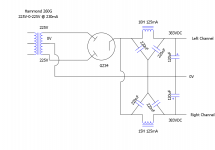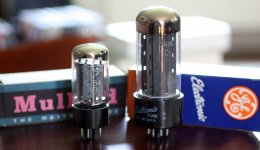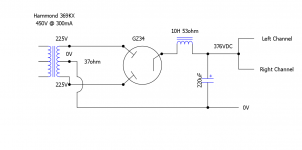It is better to have one very linear and steady power source than divide it by 2.
A 300VA transformer will perform better for 2 channels than two 150VA.
Channel separation can be achieved by using sufficient capacitance/chokes, each channel can have a choke, each driving stages can have own reducing resistor and capacitor supply.
Or you can have a regulated (transistor) voltage with capacitor (1-5 uf) decoupling at the output-trans CT. --} preferred design.
A 300VA transformer will perform better for 2 channels than two 150VA.
Channel separation can be achieved by using sufficient capacitance/chokes, each channel can have a choke, each driving stages can have own reducing resistor and capacitor supply.
Or you can have a regulated (transistor) voltage with capacitor (1-5 uf) decoupling at the output-trans CT. --} preferred design.
Last edited:
On the contrary, very few amplifiers use separate PT's for each channel.
Then I've either been looking at the wrong schematics or reading too much Morgan Jones!
There's no electrical or mechanical advantage to adding extra iron then?
Matt.
Then I've either been looking at the wrong schematics or reading too much Morgan Jones!
There's no electrical or mechanical advantage to adding extra iron then?
Matt.
Unless your having these : Explore the flagship 800 D3 - Bowers & Wilkins
no
I'll put them on my christmas list 🙂.
I've run the attached file through psud2, and it seems to have potential.
I'll need to shed some additional voltage, but I think it might be easier (for me) to do that by trial and error once the circuit is up and running than to try to calculate the specific values.
That said, I'll give it a go when I get time.
Thanks for the advice,
Matt.
Attachments
Better performance vs. higher cost + more real estate.There's no electrical or mechanical advantage to adding extra iron then?
I've run the attached file through psud2, and it seems to have potential.....
Yeah, about 200V DC. Not what you noted.
The 220nFd caps are "about nothing". So it works as a Choke Input affair. Output DC about 0.9 of VACrms. Not the 1.4 you get with a Cap Input supply.
As PSUD is generally right for supplies like this, I suspect you mis-copied a value.
The Y-connection is odd, and the mid-point is ambiguous. Is that a connection or not?
If you are very concerned about crosstalk, that hollow rectifier is common to both and significant impedance. I don't think it is a problem. But "Dual Rectifier" was a selling point for one popular amplifier (with only one power amp!) and a trivial thing to do.
Economics are VERY much better for one PT, choke, caps for two stereo channels, than two half-size power units for two channels. Yes there will be some L-R cross-talk. There are much bigger crosstalks in the recording chain and the playback space. The question is sharper when you have two *different* programs. Radio master console with football in A and garden-hour in B. But consoles universally get away with a single supply for dozens of amplifiers and several programs, without "RAH!!" behind the softer program. Of course some people lily-gild; and the cost is not prohibitive for puny 5W-100W amps.
Last edited:
With modern capacitors, low cost film compact caps and oïl capacitors, there is no need to Lose lot of voltage and torture two expensive chokes.
Also, when you // chokes you lose half of the inductance, which means you get half the inductance that you paid for.
Proper way is capacitor input.
Gz34 is a cute little rectifier, looks good on paper but really suited for pre-amplifier, Not power amplifiers, been there done that.
Also, when you // chokes you lose half of the inductance, which means you get half the inductance that you paid for.
Proper way is capacitor input.
Gz34 is a cute little rectifier, looks good on paper but really suited for pre-amplifier, Not power amplifiers, been there done that.
That's a bit contentious... It really depends on the amount of power in question. The GZ34 is a perfectly good rectifier, up to a point. One down-side these days is the price of decent ones, but that's another topic.Gz34 is a cute little rectifier, looks good on paper but really suited for pre-amplifier, Not power amplifiers, been there done that.
To the OP:
If using valve rectification, one approach which will significantly improve channel separation when using a single transformer is to use separate rectifiers for left and right channels. This helps to limit the influence of one channel over the other, and works well in my experience. This link shows my EL34 push-pull stereo amplifier with one GZ34 per channel... http://www.diyaudio.com/forums/tubes-valves/71300-photo-gallery-501.html#post3463034
Gz34 is a cute little rectifier, looks good on paper but really suited for pre-amplifier, Not power amplifiers, been there done that.
The GZ34 looks like a toy compared to the 5AU4/5V3A which regularly go for $7.50 to $12 each on epay; but you need 3.75A of filament current.
Attachments
hey-Hey!!!,
Don't write off the EF86 as pentode. The gain from a pentode is transconductance times plate load. That being delivered gm, not spec sheet, and you can thusly drop the gain by lowering the value of its plate load.
In the extreme, I built a linestage around 6AV5GA tubes. 75V on the screen grid thanks to a 0A3 voltage regulator tube, ran idle at 50 mA, and applied a 560 Ohm plate load.
cheers,
Douglas
Don't write off the EF86 as pentode. The gain from a pentode is transconductance times plate load. That being delivered gm, not spec sheet, and you can thusly drop the gain by lowering the value of its plate load.
In the extreme, I built a linestage around 6AV5GA tubes. 75V on the screen grid thanks to a 0A3 voltage regulator tube, ran idle at 50 mA, and applied a 560 Ohm plate load.
cheers,
Douglas
Good morning,
Had a quiet morning thus far, so I've found time to tinker with a new power supply.
I'd been under the impression that chokes would provide better smoothing than capacitors, especially in a single-ended amp, but perhaps I'm mistaken?
On the basis that I was wrong (again🙂), I've redesigned for an RC filter:
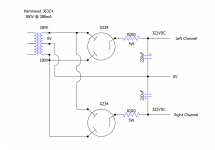
Again, I've run these numbers through PSUD2 and they seem to fit the bill. I've also taken note of the general consensus and switched to a dual rectifier design.
As ever, any thoughts/suggestions are welcome.
Thanks,
Matt.
Had a quiet morning thus far, so I've found time to tinker with a new power supply.
I'd been under the impression that chokes would provide better smoothing than capacitors, especially in a single-ended amp, but perhaps I'm mistaken?
On the basis that I was wrong (again🙂), I've redesigned for an RC filter:

Again, I've run these numbers through PSUD2 and they seem to fit the bill. I've also taken note of the general consensus and switched to a dual rectifier design.
As ever, any thoughts/suggestions are welcome.
Thanks,
Matt.
That's a bit contentious... It really depends on the amount of power in question. The GZ34 is a perfectly good rectifier, up to a point. One down-side these days is the price of decent ones, but that's another topic.
To the OP:
If using valve rectification, one approach which will significantly improve channel separation when using a single transformer is to use separate rectifiers for left and right channels. This helps to limit the influence of one channel over the other, and works well in my experience. This link shows my EL34 push-pull stereo amplifier with one GZ34 per channel... http://www.diyaudio.com/forums/tubes-valves/71300-photo-gallery-501.html#post3463034
My mistake, 5AR4(GZ34) is a nice rectifier if you look at the performance graph and limit yourself to the area with voltage/current 15% (roughly) under maximum ratings.
A good choke is the key to a SET, if you place a resistor of high value you raise the impedance a lot more, only the capacitor 220uf cannot charge fast enough through a 850R, even 20R has a diminution on amplifier dynamic capability.
Depending on your current requirement, one 5AR4 is sufficient, if you have a low resistance high current choke maybe // two would have benefits.
My advice to you is the same than earlier, you try too much to split the power into two non-efficient sides.
You can experiment, but ... 5Ar4 --- 40-to 50 uf ---- Choke ---- 220uf (doubled?) --- L / R power connected on the same capacitor.
Above gives you a better power supply
Place a 40-50uf (value required by the rectifier manual) for capacitor input.
Place the cap after the rectifier. PSUD should read higher voltage then
Place the cap after the rectifier. PSUD should read higher voltage then
Place a 40-50uf (value required by the rectifier manual) for capacitor input.
Place the cap after the rectifier. PSUD should read higher voltage then
Hi gabdx,
I tried adding the extra cap immediately after the rectifier, but I get a warning message that I've exceeded the IFRM.
The limit is 0.75A, and PSUD states the current drawn is also 0.75A, so it technically has only equalled the IFRM. I've tried other values of capacitor/choke to try and get it below 0.75A, but all come out in the 0.75-0.84A range.
Is the IFRM and absolute maximum (ie will something die - noisily and dangerously) if it's exceeded, or can we go over the limit for short periods of time relatively safely?
On another note, I'm only looking for 320VDC. Using the supply you suggest, PSUD suggests 526Vrms, after filtering. I've tried reducing the transformer voltage, but again the IFRM is exceeded.
Matt.
Place the cap after the rectifier. PSUD should read higher voltage then
Hi again,
Having thought about it, do I need the extra 40-50uF cap, given that I don't need additional voltage?
The supply I posted provides sufficient voltage and current for my circuit. I can't see the logic in adding extra parts to increase the voltage, only to then have to add even more parts to bring said voltage down again...🙂.
Matt.
Yes Matt, a softstart or some delay to full main voltage prevent overcurrent (arcing) in the rect.
The capacitor input is more efficient and less likely to cause choke buzzing and interferences.
With choke input you are sending a very crude AC into a huge coil, choke quality will be critical for this application or you may experience buzzing now or in some time, could be years.
A capacitor is more efficient and sturdy, especially oil ones to take that signal and smooth it.
But it is alright, the small caps across choke like suggested in M.J. book can help reduce choke problems maybe.
The capacitor input is more efficient and less likely to cause choke buzzing and interferences.
With choke input you are sending a very crude AC into a huge coil, choke quality will be critical for this application or you may experience buzzing now or in some time, could be years.
A capacitor is more efficient and sturdy, especially oil ones to take that signal and smooth it.
But it is alright, the small caps across choke like suggested in M.J. book can help reduce choke problems maybe.
But it is alright, the small caps across choke like suggested in M.J. book can help reduce choke problems maybe.
Hi gabdx,
Thanks again for the help.
Given that I'm already using a valve rectifier to take advantage of it's inherent soft-start capabilities, I'm reluctant to have to provide a second soft-start circuit!
I'm sure you're correct when you say using a capacitor pre-choke does a better job, but for me it seems to be causing more problems than it's solving.
My main problem is in finding an (affordable) transformer that'll deliver >200mA without ending up with a filtered voltage way above what I require. Add to that the current spiking and need for additional circuitry, I'm inclined to keep it simple and take my chances.
The circuit below fits my needs nicely, although the voltage is a little higher than I'd like. I've taken your advice and re-instated the snubbers, as recommended by Mr Jones, stealing the 220nF value verbatim, as:
'...curiously, 220nF is often a practical value...'
anything curious gets my vote 😉.
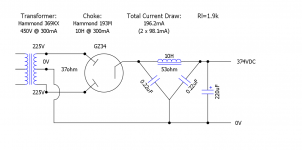
I hope you don't think that by refusing your advice I'm suggesting it's invalid, I'm merely choosing to ignore it, fully aware that I'm doing so at my own peril 🙂.
Having visited your website you obviously know your onions (to coin a phrase), Le Barbare is a particularly stylish beast, but sadly a little out of my price range.
Matt.
Hi Matt,
I don't if these are easy to source in the UK, but the Anteks are priced well and come in many different output voltages that then will allow you to use the capacitor input. They don't have a 5V supply, but you could use something like the Hammond 166MS for the rectifier filament. I've used many of the Anteks, they perform well. Just an FYI.
Grids
166MS - Hammond Mfg.
All the best,
Scott
I don't if these are easy to source in the UK, but the Anteks are priced well and come in many different output voltages that then will allow you to use the capacitor input. They don't have a 5V supply, but you could use something like the Hammond 166MS for the rectifier filament. I've used many of the Anteks, they perform well. Just an FYI.
Grids
166MS - Hammond Mfg.
All the best,
Scott
- Status
- Not open for further replies.
- Home
- Amplifiers
- Tubes / Valves
- Designing a Single-Ended Triode EL34 Power Amp
